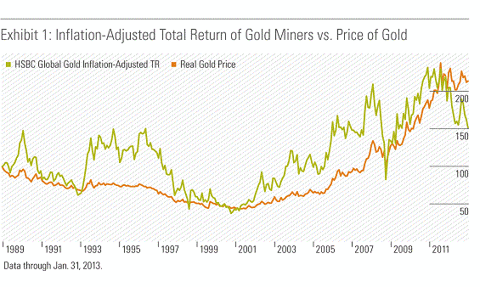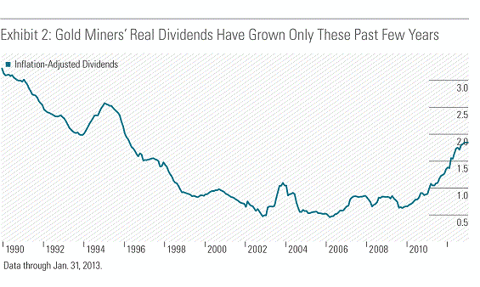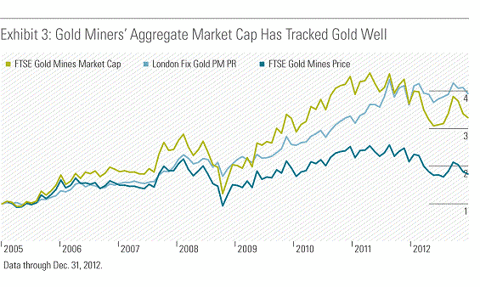A Golden Cross To Bear
Mar 29 2013, 08:35
by: Morningstar
By Samuel Lee
Gold miners have been an embarrassment. A dollar put in gold five years ago would be worth about a $1.70 today; that same dollar in Market Vectors Gold Miners ETF (GDX) would be worth only $0.80. What explains this sorry performance? In theory, gold miners are supposed to have operational leverage, because their up-front fixed costs are much higher than their ongoing costs. It takes a colossal level of incompetence to have negative operational leverage when the price of your goods sold rises 70%.
The popular story is that physically backed exchange-traded funds like SPDR Gold Shares (GLD) came along and soaked up investing dollars that otherwise would have gone to miners, depressing their valuations. While there's some merit to the story, it doesn't explain gold miners' continued weakness (markets are forward-looking). It also seems to imply a ludicrously high premium on the convenience of owning gold via an exchange--gold certificates, futures, and even physical storage were feasible options before gold ETFs came along. Finally, it doesn't explain the abject failure of gold miners to provide leverage to gold prices before the gold ETF era.
In Exhibit 1, I've charted the cumulative total returns of the HSBC Global Gold Index and gold prices. Gold miners have for the most part tracked gold's price but with a lot more volatility. Even counting reinvested dividends, they historically have failed to offer a reasonable long-term spread over gold's returns.
(click to enlarge)

The truth is gold miners historically have been miserable capital allocators in a capital-intensive industry. If the miners had just focused on returning cash to shareholders and keeping costs down, their total return would have been much, much higher.
Exhibit 2 shows gold miners' real per-share dividend growth. For much of the 1990s, dividends persistently declined along with gold prices, but they only slowly grew as gold's price marched ever upward.
(click to enlarge)

Miners kept payouts low, using their torrential profits to acquire or develop more mines. They issued shares to fund their spending sprees. From the beginning of 2005 to the end of 2012, gold miners' aggregate market cap grew by more than 16.0% annualized, while their aggregate price grew only about 7.7% annualized. The 8.0% annualized gap between market cap and price performance represents share dilution. Share issuances often signal future underperformance, in part because managers time the market to sell at peaks and in part because firms often fail to realize the expected benefits of major capital expenditures.
(click to enlarge)

This should be a splash of cold water for those who believe the gold/miner price ratio tends to converge on its long-run average. In all fairness, over short periods, the ratio does seem range bound, such as from mid-2006 to mid-2008, when the GLD/GDX ratio hovered between 1.5 and 2.0, and it exhibited strong mean reversion after it spiked during the financial crisis. However, the ratio is misleading when compared with its average over longer periods; the gold price/aggregate market-cap ratio does a better job explaining gold miners' movements.
Incidentally, this ratio is signaling that gold miners are oversold right now. David Einhorn is perhaps the most famous gold-miner bull. As of Sept. 30, 2012, his hedge fund Greenlight Capital owned about 6 million shares of GDX, making him the fund's fourth-biggest institutional shareholder.
Einhorn said in November 2011, "With gold at today's price, the mining companies have the potential to generate double-digit free cash flow returns and offer attractive risk-adjusted returns even if gold does not advance further." GDX was then trading at nearly $60 a share. Now it's trading near $37. Ironically, Einhorn's fundamental case has actually played out. Gold miners have ample cash flows right now and are scaling back their capital expenditures. They're raising dividends at a swift pace.
Despite seemingly attractive fundamentals and technicals, the gold-mining sector has terrible structural features that should give the long-term investor pause. Foremost, the capital expenditures are huge and ongoing. Most of the easily mined sources of gold are tapped out or mature, so to keep production going, miners now have to process lower grades of ore, dig deeper, or venture into unstable regions where infrastructure and rule of law are nonexistent or a shambles. Not only that, but major projects often run afoul of unexpected cost overruns or disappointing yields.
It's generally not a good idea to own firms that require large capital expenditures under conditions of high uncertainty, especially when their managers have such a storied history of incompetence.
Humans are overconfident and optimistic, so they tend to overestimate the rewards and underestimate the costs of major capital expenditures (whether it's a merger, a tunnel connecting New Jersey to New York, or a new mining complex). There are also agency costs to consider. Managers get paid for short-term performance, but shareholders end up with long-term performance.
It's no surprise that managers often overstate the rewards of these big projects that don't pay out until years later. There's also that dreaded institutional imperative: the tendency for managers to grow their companies just for the sake of growing.
These aren't insoluble problems, of course. Oil company Exxon Mobil (XOM) has faced similar problems and made shareholders a lot of money. Exxon achieved this in large part because of its shareholder-centric culture. The firm's dividend has grown like clockwork since the 1970s. You can be sure Exxon's current managers don't want to do anything stupid to put the dividend at risk. Few gold miners have shown a similarly obsessive focus on prudent capital allocation and sustainable growth over as long a period. Of those firms that Morningstar equity analysts cover, only Randgold Resources (GOLD) and Eldorado Gold Corp (ELD) earn the highest stewardship rating of exemplary.
And Morningstar's research states that only Eldorado Gold has an economic moat, "which is largely attributable to [the] management team amassing a portfolio of low-cost, long-life mining assets without paying an arm and a leg in terms of capital spending." However, both firms were founded in the 1990s, whereas gold-mining has been a business for centuries. Where did all the wide-moat firms of yesteryear go? Maybe they never existed.
Though many gold miners are cleaning house, and new managers are solemnly swearing to forgo the vices of the past, you can be sure that the CEOs preaching virtue will be sorely tempted to acquire even more mines should the good times come back. They are only human. For now, though, miner yields are the highest they've been in years, and dividends are growing at a nice clip. In the short and medium terms, gold miners look like a decent buy for what you're getting: A source of returns relatively uncorrelated to the stock and bond markets. In the long run, however, it's not clear whether the miners' ample cash flows will be returned to shareholders or sacrificed to the institutional imperative. I'm not a fan of betting against human nature.
0 comments:
Publicar un comentario